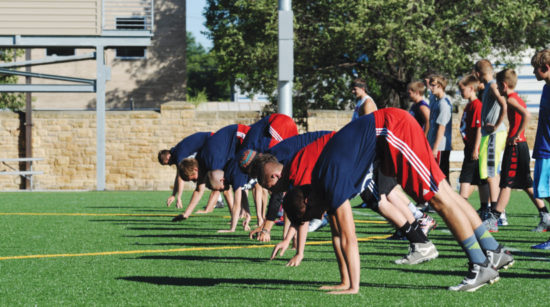Productive practices start with a purposeful warmup
All sports are better served by preparing the body and mind for movement

Prior to beginning any workout, practice or game, it’s important that players go through a proper warmup. Jumping right into a high-intensity activity may increase the chance of injury.
Don’t confuse warming up with stretching, as they are two completely separate activities. A warmup consists of low intensity sport-specific movements involving most of the muscles in the lower body.The goal of the warmup is to raise the body’s core temperature a few degrees to lubricate the joints and make the muscles more elastic. This helps prepare the body and mind for the workout to follow. A thorough warmup lasts as little as five to eight minutes and results in a light sweat. The warmup consists of the specific movement patterns used in the sport. For example, basketball:
- Sprinting
- Back pedaling
- Defensive sliding
- Jumping (and landing)
- Pivoting
- Lunging
This ensures the muscles and joints used during competition are sufficiently prepared, so your athletes are 100 percent ready to play once practice begins. Have players go through a structured warmup pre-workout, pre-practice and pre-game. This consistency also helps with mental focus and preparation.
Establishing flexibility
Once players have completed a thorough warmup, the next phase of preparation is flexibility. Have players go through a series of dynamic flexibility exercises prior to workouts, practices and games.
Dynamic flexibility consists of exercises that increase the range of motion in a joint or series of joints while the player is continuously moving. There are four benefits to performing dynamic movements versus a traditional static stretching routine.
1. By continuing to move, the players maintain the warmup effect (players may lose the two- to three-degree increase in core temperature by sitting and stretching for 10 to 15 minutes).
2. Dynamic flexibility, when performed appropriately, prepares the muscles and joints in a more specific manner than static stretching. Given that the workout, practice or game is going to consist of dynamic movement, it’s important to prepare the body in a similar manner. This does not advocate anything dangerous or inappropriately ballistic.
3. It helps with coordination, motor skills and a player’s ability to jumpstart his or her central nervous system. These traits are critical for younger athletes who still are learning their abilities and limits of their bodies.
4. Dynamic flexibility sufficiently prepares the mind for the workout to follow. This dynamic warm-up causes each player to focus and concentrate on the task at hand.
Additionally, it’s important to address the mobility of the ankles, hips and upper back (thoracic spine). Mobility in these areas is vital for players to stay injury-free and move efficiently. Every time a player runs or jumps, they perform triple extensionthey extend at the ankles, they extend at the knees and they extend at the hips. If any one of those three joints can’t go through a full range of motion, then the player isn’t able to run as fast or jump as high as they are capable.
Conversely, every time a player lands from running and jumping, he or she wants the impact to dissipate through those same three joints. If any one of those three joints can’t flex properly to absorb the impact, it adds tremendous pressure to the next closest joint. For example, players with tight, immobile ankles or hips are not only limiting their potential to run and jump, they also are causing additional, and unnecessary, impact on their knees.
Reflecting overall training
The warmup needs to be a reflection of the overall training philosophy:
- Train in a way that helps reduce the occurrence and severity of injuries — both acute and cumulative.
- Train in a way that improves how players move and function during competition.
- Train in a way that instills sound work habits, accountability, discipline, respect, communication, competitiveness, toughness and proper exercise technique (and footwork).
A player’s athleticism, and thus strength and conditioning program, is the foundation of the player’s sport. The warmup lays the foundation for every workout, practice and game. A sturdy foundation helps the athlete remain injury free and gives that person the potential to perform his or her skills at a higher level.


